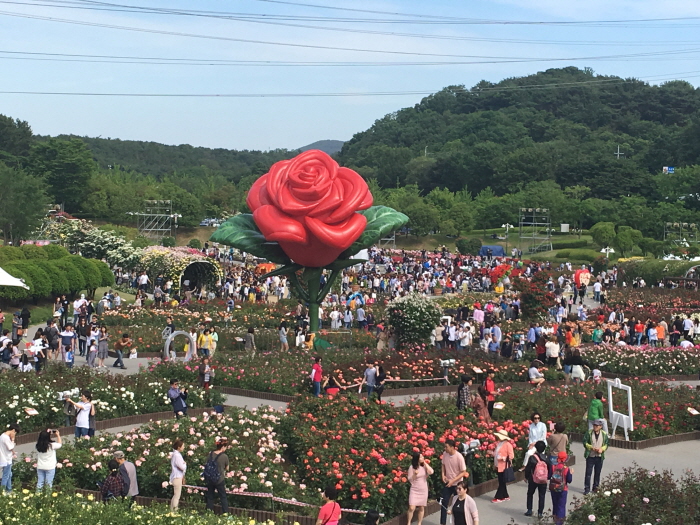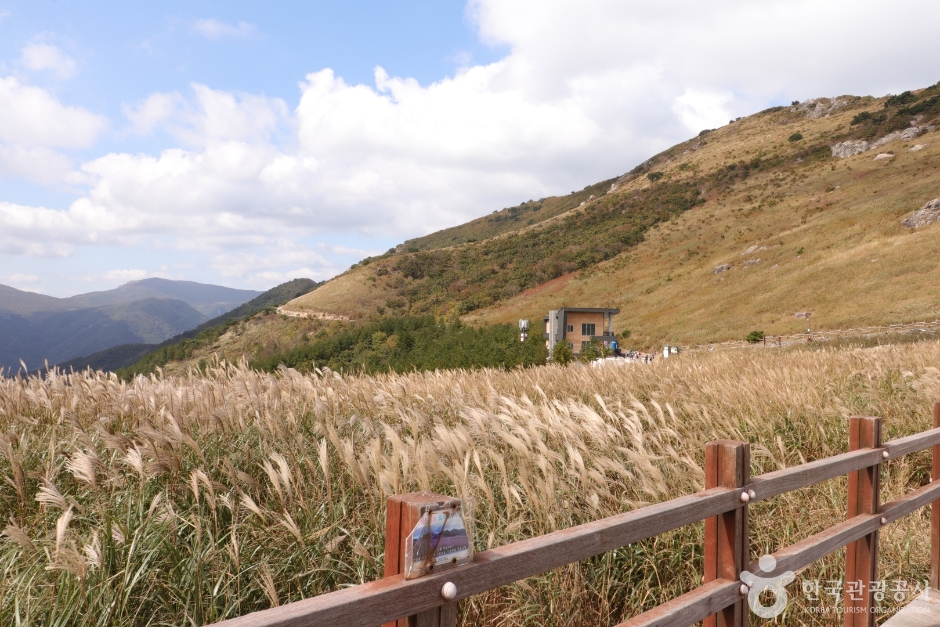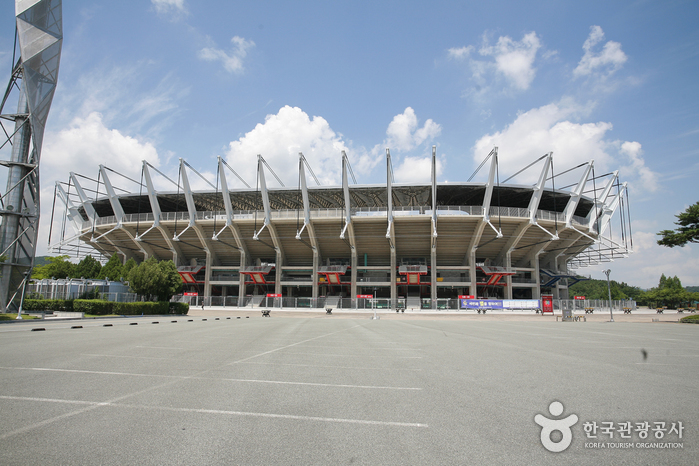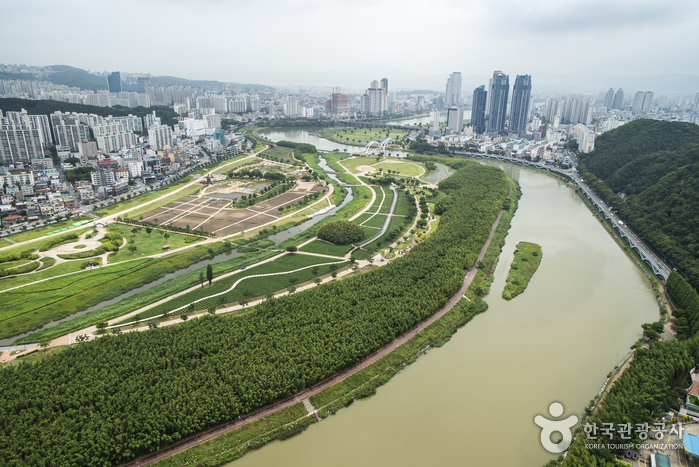Ulsan Grand Park Rose Festival (울산대공원 장미축제)
0m 23693 2024-04-17
377, Nambusunhwando-ro, Nam-gu, Ulsan
+82-52-229-3341
Ulsan Grand Park Rose Festival has on exhibit about 3 million roses in a vast rose garden. The festival offers diverse views of beautiful roses along with dynamic performances and participation events.
Ulsan Grand Park (울산대공원)
961.1165110151235m 43489 2023-02-02
94, Daegongwon-ro, Nam-gu, Ulsan
+82-52-271-8816
Ulsan Grand Park, located in Namgu Ok-dong, is an ecotype city park with multiple attractions. The park offers huge swimming pool, a theme park, an outdoor concert area, multipurpose sports field and more. The outdoor theme park offers 4 different size ponds, a walking trail, playgrounds, outdoor concert hall, squares, multipurpose sports field and picnic areas. Also near the South gate, you can find a butterfly field, rose garden, and a small zoo.
Ulsan Grand Park Light Festival (울산대공원 빛 축제)
961.1165110151235m 15972 2022-04-06
94, Daegongwon-ro, Nam-gu, Ulsan
• 1330 Korea Travel Hotline: +82-2-1330 (Korean, English, Japanese, Chinese) • For more info: +82-52-226-0305
Ulsan Grand Park Light Festival offers beautiful light displays and shows in a variety of zones under an overall theme that changes each year.
Ulsan Museum (울산박물관)
2.2 Km 17340 2021-04-30
277, Duwang-ro, Nam-gu, Ulsan
+82-52-222-8501
Ulsan Museum is an archive of the past, present, and future of Ulsan City. The museum facilities include a history hall giving a general outline of the city from the prehistoric to the modern times, an industry hall showing Ulsan as the industrial capital of Korea, and a children’s experience hall for educational purposes. This eco-friendly museum equipped with advanced exhibition and education facilities is a model cultural space to help visitors understand Ulsan’s identity.
Taehwagang National Garden and Simni Bamboo Grove (Eunhasugil) (태화강 국가정원 십리대숲 (은하수길))
2.3 Km 0 2023-01-25
Taehwa-dong, Jung-gu, Ulsan
+82-52-229-3147
Simni Bamboo Grove is a bamboo forest that stretches over about 4 km along the Taehwagang River and is a natural garden using bamboo that has grown naturally for a long time. It is a healing space in the city where the river wind blowing through the bamboo and the whisper of bamboo leaves tickle your ears.
A unique night garden where the Milky Way descends at night. It is a must-see course where you can feel as if you are walking along the Milky Way in the night sky as colorful lights meet bamboo. In addition, through the outdoor escape room game
Twelve Scenic Places of Ulsan City (울산 12경)
2.3 Km 37283 2024-02-20
Ulsan Metropolitan City
Twelve Scenic Places of Ulsan City encompass the stunning landscapes of Ulsan, showcasing the natural beauty and cultural richness of the region. These include the bamboo forest in Taehwagang Gardens, the majestic rock formations in Daewangam Park set against the backdrop of the azure sea, the four seasons of Gajisan Mountain, the silver grass field of Sinbulsan Mountain, the breathtaking sunrise at Cape Ganjeolgot, the ancient Petroglyphs of Bangudae Terrace and Cheonjeon-ri from the Neolithic era. Other scenic spots include the Gangdong and Jujeon Pebble Beach, Ulsan Grand Park, the captivating night view from the Ulsandaegyo Bridge Observatory, the charming Jangsaengpo Whale Culture Village, the serene Oegosan Onggi Village, and the picturesque Naewonam Valley in Daeunsan Mountain.
Ulsan Munsu Football Stadium (문수축구경기장)
2.3 Km 12813 2021-05-26
44, Munsu-ro, Nam-gu, Ulsan
+82-52-220-2002
Ulsan Munsu Football Stadium’s exterior design looks like a crane, which represents the bird of Ulsan. The design of the roof and the pillars represents the youth and dynamics of the city. Other representative symbols include a whale and big crown of the Silla dynasty.
Taehwagang River (태화강)
2.3 Km 20902 2020-09-05
Mugeo-dong, Nam-gu, Ulsan
+82-52-120
Taehwagang River cuts across the city of Ulsan from the west to east and originates from Tapgolsaem Spring on Baegunsan Mountain. The 47.54-kilometer-long river passes through downtown Ulsan and empties out into Ulsan Bay on the East Sea. Not just a symbol of pride for the people of Ulsan, the river has long since been a precious commodity that has played a pivotal role in Ulsan culture and history. There are several attractions and amenities near the river such as a bamboo forest park, grassy fields, a pampas grass colony, trails, and exercise facilities. The river itself is home to many freshwater fish, while the riverside area is a famous habitat for migratory birds.
Olive Young - Ulsan Industrial Tower Branch [Tax Refund Shop] (올리브영 울산공업탑)
2.4 Km 0 2024-04-23
17, Samsan-ro, Nam-gu, Ulsan
-
Taehwagang National Garden (태화강 국가정원)
2.4 Km 43655 2024-01-03
154 Taehwaganggukgajeongwon-gil, Jung-gu, Ulsan
The Taehwagang River cuts across the heart of Ulsan and flows into Ulsan Bay, which is connected to the East Sea. The river basin, which stretches 36 kilometers from east to west and 28 kilometers from north to south, is mostly comprised of mountainous terrain, but there is fertile land on both sides of the river and at the southern end of the river. The river is presently an important source of drinking water for the citizens of Ulsan.
The field around the midpoint of Taehwagang River was left abandoned for a long time before it was founded as Taehwagang National Garden, preserving nature while providing a resting spot to the citizens of Ulsan. The garden is over twice the size of Yeouido Park in Seoul, and consists of natural water and a lush bamboo forest, known as Simnidae Forest, along with canola and forage barley fields. Simnidae Forest was once in danger of demolition as part of the government's flood control plans but remains preserved thanks to community efforts. Preservation efforts led to turning the area into Taehwagang National Garden of today, which was recognized as Korea's second national garden in 2019.





![Olive Young - Ulsan Industrial Tower Branch [Tax Refund Shop] (올리브영 울산공업탑)](http://tong.visitkorea.or.kr/cms/resource/89/2884189_image2_1.jpg)
 English
English
 한국어
한국어 日本語
日本語 中文(简体)
中文(简体) Deutsch
Deutsch Français
Français Español
Español Русский
Русский